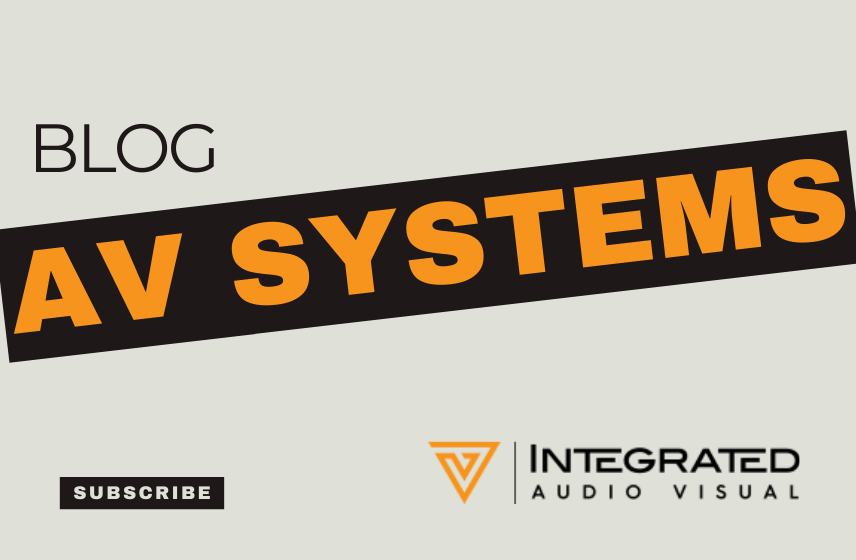In a world where innovation drives experience, today’s architects and designers are challenged to strike the perfect balance between form and function. And nowhere is that balance more essential than in the integration of audio-visual (AV) systems.
Gone are the days when AV technology had to be bulky, obtrusive, or purely utilitarian. With the right approach, AV systems can be seamlessly blended into architectural spaces, enhancing both aesthetics and performance. Whether you’re designing a luxury residence, a corporate boardroom, or a high-end hospitality venue, AV should support your vision—not compete with it.
Why Aesthetic AV Integration Matters
Clients today expect technology to “just work”—but also to stay out of sight unless it’s actively being used. This growing demand for tech invisibility is reshaping the way AV systems are designed and installed.
Without thoughtful integration, even the most advanced equipment can:
- Disrupt clean lines and minimalist aesthetics
- Create cable clutter and wall scars
- Require awkward retrofitting or compromise design intent
Modern AV design solves this by harmonizing technology with architecture—amplifying elegance without sacrificing performance.
Key Strategies for Seamless AV Integration
🎛️ 1. Hidden Wiring and Infrastructure
Exposed wires and cables are an immediate eyesore. During construction or renovation, structured cabling and pre-wiring ensure all AV components can be connected discreetly behind walls, floors, or ceilings.
Benefits:
- Clean, uncluttered surfaces
- Simplified long-term maintenance
- Future-proofing for tech upgrades
🔊 2. In-Wall and In-Ceiling Speakers
High-quality audio doesn’t have to come from boxy speakers that stick out like sore thumbs. Flush-mount in-wall and in-ceiling speakers deliver immersive sound while maintaining visual harmony.
Benefits:
- Sound that fills the space without visual intrusion
- Paintable grilles for seamless blending with wall colors
- Available in high-performance options for audiophiles
🎥 3. Ceiling-Mounted Projectors and Lift Mechanisms
Projectors are vital in many environments—but that doesn’t mean they have to be visible 24/7. Ceiling-mounted projectors, often paired with motorized lifts, can retract into concealed compartments when not in use.
Benefits:
- Maximized ceiling aesthetics
- Protection for sensitive equipment
- Flexible use of multi-purpose spaces
🖥️ 4. Motorized Screens and Panels
Motorized AV components, such as projection screens or display panels, are designed to appear only when needed. With a tap of a button or a programmed scene, they can rise from furniture, descend from ceilings, or slide out from walls.
Benefits:
- No interference with interior design elements
- On-demand access to technology
- Perfect for conference rooms, home theaters, or lounges
💡 5. Custom Enclosures and Architectural Coordination
For truly bespoke spaces, custom cabinetry and millwork can house AV gear while matching the materials, colors, and textures of the space. Working with architects and interior designers early in the process is key to aligning tech with design.
Benefits:
- Unified design language across the entire space
- Personalized aesthetic results
- Enhanced property value and user experience
AV Systems That Complement, Not Compete
When AV systems are considered part of the architectural language—rather than afterthoughts—they become powerful assets. With smart integration, your technology can:
- Preserve visual symmetry
- Support lighting and ambiance goals
- Reinforce the purpose of a space, whether it’s productivity, comfort, or entertainment

Who Benefits from Design-Focused AV Integration?
This blend of AV and architecture is transforming experiences across industries:
- Luxury Homes: Invisible sound systems, hidden TVs, and integrated lighting scenes create elegant living spaces.
- Corporate Offices: Clean-lined conference rooms with retractable screens and discreet microphones support a polished professional image.
- Retail & Hospitality: Ambient music and interactive displays are woven into the environment, not bolted on as an afterthought.
- Museums & Galleries: Multimedia experiences enhance storytelling without distracting from exhibits.
Collaborate Early, Design Smarter
The secret to flawless AV integration? Planning early and collaborating often. Architects, designers, and AV integrators should work hand-in-hand from the concept phase through final installation.
When AV is considered part of the architectural DNA, the result is a space that looks stunning, works effortlessly, and feels cohesive.
Final Thoughts
Design and technology are no longer at odds—they’re partners in creating exceptional spaces. By blending AV systems into architecture through thoughtful planning, hidden infrastructure, and discreet hardware, you deliver environments that are both beautiful and functional.
Don’t let tech disrupt your design. Instead, let it enhance it invisibly.
Ready to Integrate AV with Elegance?
Whether you’re an architect, designer, or property owner, our team specializes in aesthetic AV integration tailored to your vision. Reach out today to discuss how we can help make your space smarter, sleeker, and sound-ready—without compromising style.


